Gila Trout Recovery & Angling
Click the tab headings below for more Gila Trout Recovery and Angling information and regulations.
Also, check out the Spring 2017 edition of New Mexico Wildlife magazine’s article Restoration of Gila trout opens door for anglers.
Gila Trout
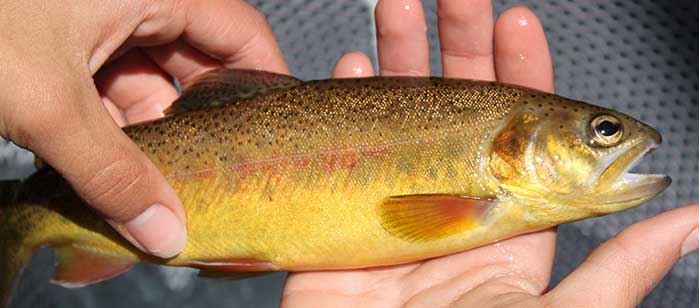
Gila trout (photo by Craig Springer)
Gila Trout have been described as “taking their colors from the New Mexican sunset”, an apt description. Their iridescent gold sides blend to a darker shade of copper on the gill covers. Small, profuse spots cover the upper half of the body and a faint, salmon-pink band is present on adults, particularly during spawning season. A yellow cutthroat mark is present on most larger fish and parr marks are commonly found on adults. Because Gila Trout are often found in small streams, they rarely grow larger than 12 inches, but given adequate habitat can grow to over 15 inches.
Gila Trout typically spawn in early spring when water temperatures are rising. They reach sexual maturity by age 3 and live between 4 and 6 years. Gila Trout are capable of hybridizing with Rainbow Trout which has greatly reduced the range of pure Gila Trout.
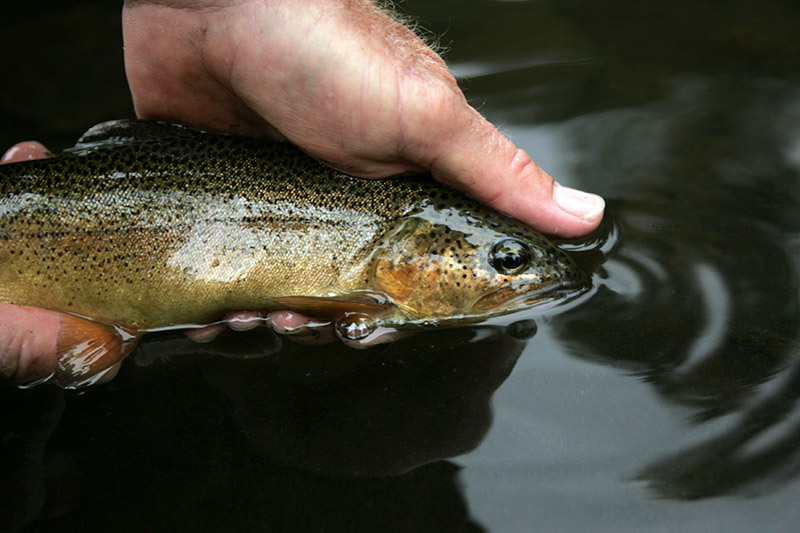
Photo by G. McReynolds
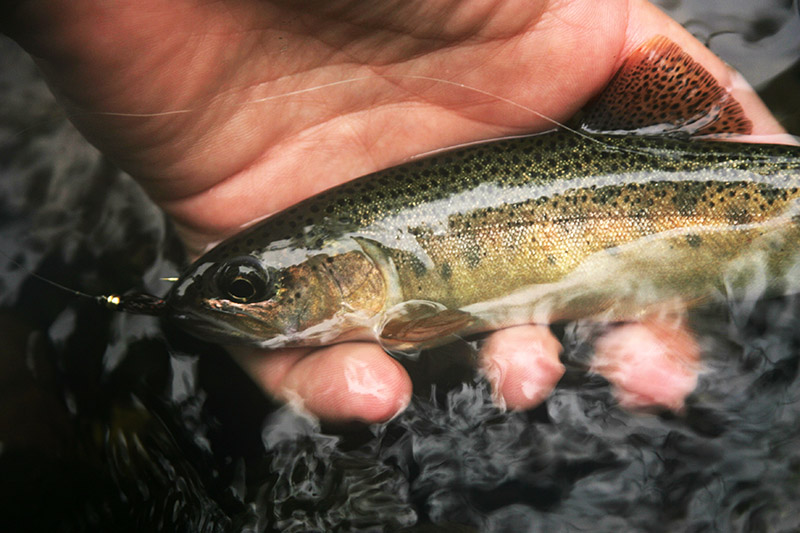
Photo by G. McReynolds
Where are they found?
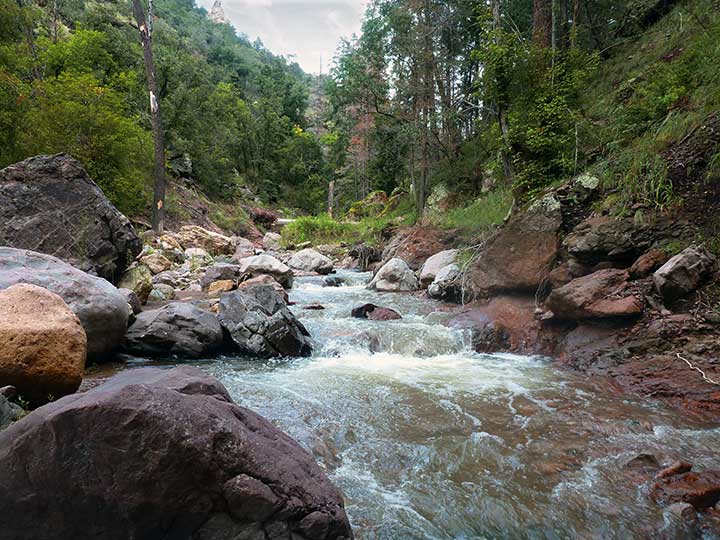
Trout habitat in Mineral Creek, a tributary to the San Francisco River in Catron County, NM. (photo NMDGF)
The Gila Wilderness Area was created in June 1924 at the urging of the conservation pioneer Aldo Leopold and was the world’s first designated wilderness. As part of congressionally designated wilderness, there are no roads and the only travel permitted is by foot or horseback. Logging is not allowed, nor any commercial use except livestock grazing. Hunting and fishing activities, however, are open to everyone under laws set by the New Mexico State Game Commission.
History
Gila Trout are relatives of Pacific Salmon and Rainbow Trout, originally making their way up into the mountains of the Southwest by migrating from the Gulf of California. As the climate and landscape changed, they could no longer move between the mountains and the ocean. Their range was reduced to the mountain streams of the Gila, San Francisco, and Verde river basins in New Mexico and Arizona, where they evolved to survive harsh conditions. By the late 1800’s land use practices led to habitat deterioration. Meanwhile, overfishing reduced wild stocks while stocking of nonnative fishes increased. Nonnative trout compete with, predate upon, and sometimes interbreed with Gila Trout. These issues cumulatively began to take their toll on Gila Trout, and in the 1950’s, when the species was officially described, their range had been significantly reduced and populations remained in only five streams.
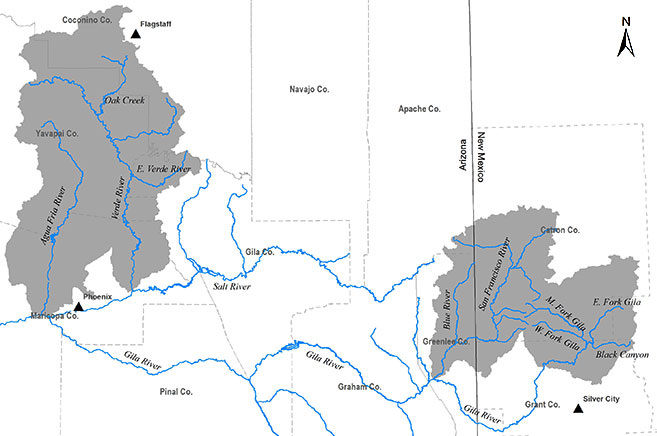
Historical distribution of Gila trout
Conservation
Gila Trout was the first western North American fish with a management program focused on conservation. These efforts began as early as the 1920s when the New Mexico Department of Game and Fish established the Jenks Cabin Hatchery in the heart of the Gila and began raising Gila Trout. Around the same time, the agency established a policy of not stocking nonnative salmonids into streams known to support Gila Trout. In the 1950s, the first Gila Trout streams were closed to angling. Despite these efforts, Gila Trout was listed as endangered under the Endangered Species Act of 1973 and the New Mexico Wildlife Conservation Act of 1974.
Throughout the following decades, Gila Trout were returned to several streams in New Mexico after nonnative trout had been removed. These efforts lead to their down-listing to threatened in 2006.
[/fusion_text][/fusion_builder_column_inner]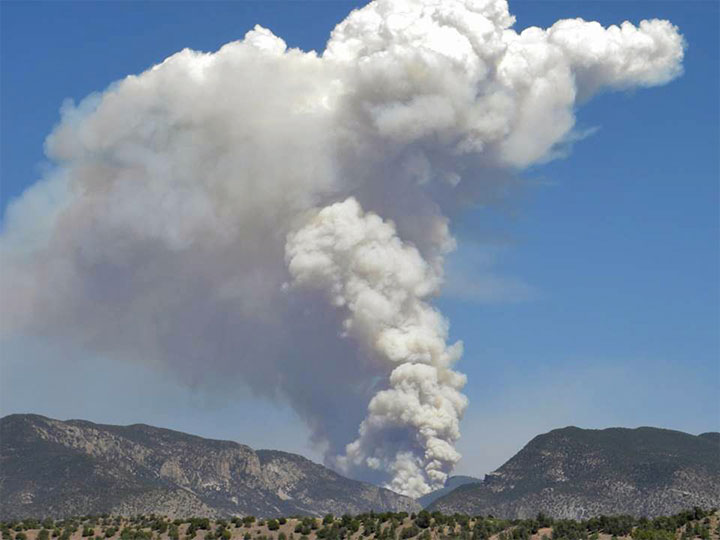
The Whitewater Baldy Fire burned through almost 300,000 acres of the Gila National Forest in spring 2012. (photo USFS-Gila National Forest)
Today, Gila Trout conservation is guided by the Gila Trout Recovery Plan (2022). A diverse team of State and Federal agencies as well as university researchers and non-governmental organizations collaborate on Gila Trout conservation. The partners include New Mexico Department of Game and Fish, US Forest Service, US Fish and Wildlife Service, the University of New Mexico, the Arizona Game and Fish Department, and Trout Unlimited. The agencies continue a program of stream restoration – removing nonnative species, constructing barriers to prevent nonnatives from reinvading, and reestablishing Gila Trout.
In addition to competition and hybridization with nonnative trout, wildfire is a major threat to the survival of Gila Trout. Toxic ash flows following high-intensity wildfires often result in fish kills. Multiple wildfires have had the direct and immediate effect of eliminating fish from a stream and because of this, Gila Trout are often evacuated from streams that are threatened by wildfires. The nearly 300,000 acre Whitewater Baldy Fire, burned through nearly half of the existing Gila Trout streams in 2012 ,eliminating Gila Trout from six of the eight streams that were within the burned area and forcing evacuations from three streams following the fire. The 2021 Johnson Fire and 2022 Black Fire negatively impacted multiple populations of Gila Trout, including eliminating several populations and severely altering habitat in several watersheds.
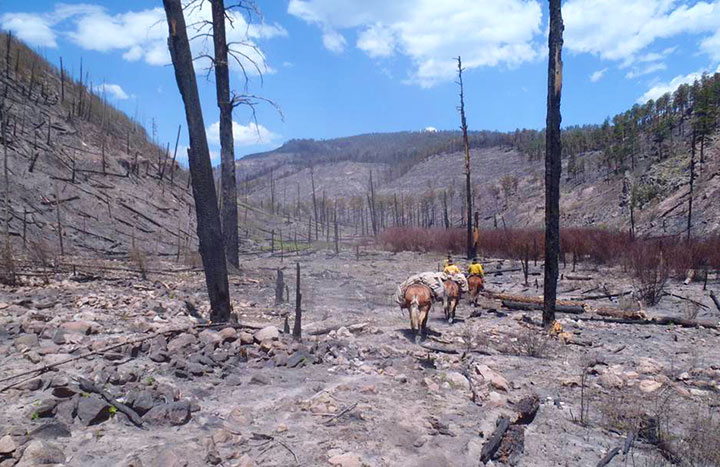
Riding through the upper West Fork Gila River Drainage to rescue and evacuate Gila trout from Whiskey Creek after the 2012 Whitewater Baldy Fire. (photo USFWS)
Current conservation efforts consist of returning Gila Trout to the streams affected by wildfires, continuing to establish them in new streams within their historical range, and developing opportunities to fish for this rare trout.
Gila Trout Angling Streams
Content updated 08-28-2024.
A free Gila Trout angling permit is required for all Gila Trout waters listed below except Lake Roberts and Gwynn Tank. The permit can be acquired online by clicking “free permits” after you purchase your fishing license. Check the NM Fishing Rules and Info Booklet for current regulations. Catching a Gila Trout is a step towards completing the New Mexico Trout Challenge. Follow the link for more details of the challenge. An annual survey of Gila Trout anglers is conducted by the Department. Please consider responding if you receive the email.
Use the search function on the Fishing Waters Map to locate these waters:
Click to reload map above if borders or tools are missing, or view mobile map / full screen version in a new browser window.
Mogollon Creek from waterfall to Trail Canyon: Open July 1 – October 31, catch and release, single hook/artificial lure.
Willow Creek: 2 Gila Trout limit, any legal tackle. There is a naturally reproducing population of Gila Trout in Willow Creek and the best fishing can be found in the headwaters area upstream of the private property.
Gilita Creek: 2 Gila Trout limit, unlimited Brown Trout, any legal tackle.
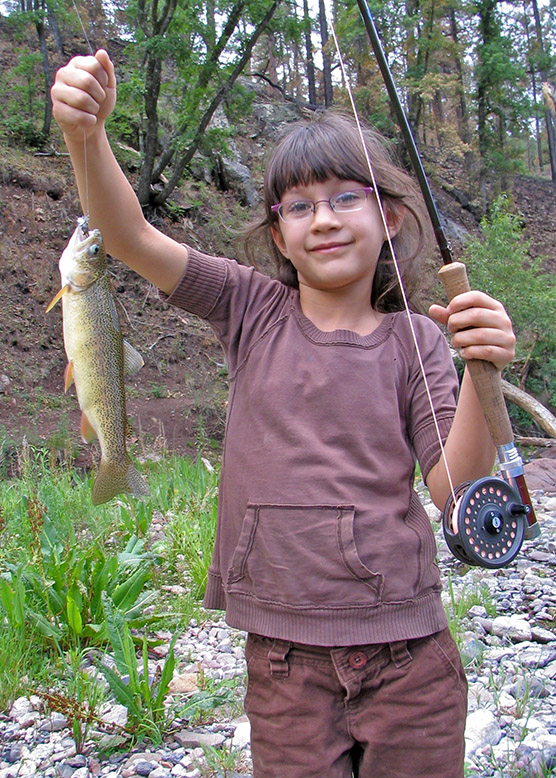
Willow Springer hefts a Gila trout in New Mexico’s Black Canyon (photo Graig Springer)
Black Canyon above fish barrier: Open July 1 – October 31, catch and release, single hook/artificial lure. Trout populations were severely impacted by the 2022 Black Fire.
[wpfilebase tag=file id=1632 tpl=simple /]Black Canyon below fish barrier: 5 trout limit, any legal tackle. Severely impacted by the 2022 Black Fire.
West Fork Gila River from headwaters to Ring Canyon: 5 trout limit, any legal tackle.
Gila River Forks Area: 5 trout limit, any legal tackle.
Sapillo Creek: 5 trout limit, any legal tackle.
Mineral Creek: 2 Gila Trout limit, any legal tackle.
Lake Roberts: 5 trout limit, any legal tackle. No Gila Trout Permit required. Gila Trout are occasionally stocked into Lake Roberts when surplus fish are available.
Gwynn Tank: 5 trout limit, any legal tackle.
Whitewater Creek (Catwalk section): 2 Gila Trout limit, any legal tackle. The newest Gila Trout stream open to fishing.
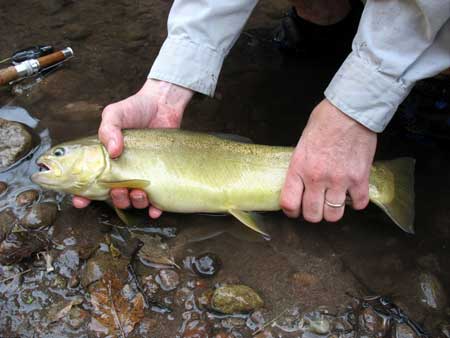
Hatchery Gila Trout – Caught in West Fork Gila River 2008 (Photo by R. C. Helbock)
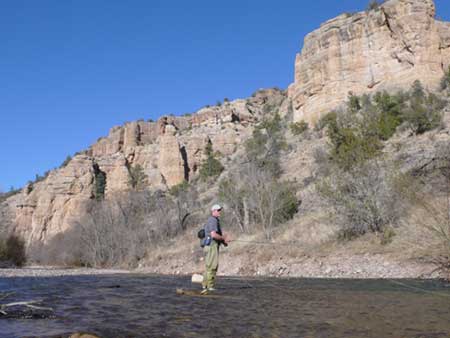
Fishing the Gila Forks 2008 (Photo by G. McReynolds)
Current Projects
The Department is currently working on multiple Gila Trout recovery projects as well as projects to enhance Gila Trout angling opportunities. These include:
- Improving habitat in Willow Creek
- Improving habitat and angler accessibility in the Catwalk Recreation Area of Whitewater Creek
- Major renovations and upgrades at the Glenwood State Fish Hatchery to raise and grow out Gila Trout.
- Investigating other streams for restoration activities

